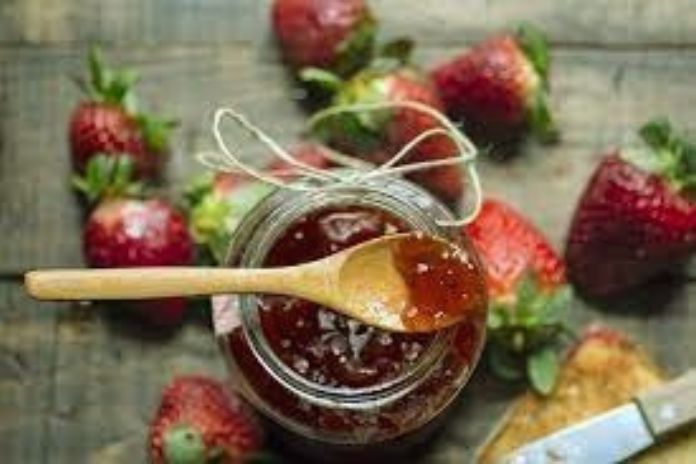How to know if the jam is cooked? What to do if it is too liquid? How much sugar do you need? With our advice, success is guaranteed!
Is Gelled Sugar To Be Avoided?
On its own, it can be criticized for masking the flavors, but well dosed, it brings an appreciable texture because it contains pectin, accelerates the setting, and preserves the color of the fruits. Mixing the two gives balanced results in the proportions of two-thirds and one-third. For example, for 1 kg of fruit: 400 to 450 g of granulated sugar and 200 to 250 g of gelled sugar.
To your calculators for the rule of three, but not to the nearest gram, we round! It can be eaten spread on toasted bread, added to plain yogurt, or as a garnish on a pancake. And whoever has never dipped his finger in it to taste it, stand up. We all love jam! Even more so when it’sit’s homemade. However, before starting, some questions deserve answers to avoid the mess.
Which sugar to choose? White, red, or gelling? How to use them? At what temperature? Depending on what you want: a neutral or slightly caramelized taste, classic or quick cooking, know this for successful jams, choosing the suitable sugar is essential!
I Am Making Jams: What Type Of Sugar To Choose?
First, this reminder! Sugar is sucrose extracted from beets or cane. After successive treatments of purification and evaporation by heating, crystallized sugar is obtained, which is grainy. That of the beets comes out white that of the red cane is more or less dark. Colored by natural pigments and residues, it is more distinctive.
- White granulated sugar: neutral, it does not change the taste or the color of the jams, and it is the best on the market because it is neither crushed nor compacted.
- Brown sugar: “pure cane sugar” darkens the fruit and brings a caramelized touch. If your choice is guided by dietetics, prefer it organic and unrefined. The more organic matter it contains, the more brown and potent it is. Let’sLet’s mention rapadura, concentrated and dehydrated cane juice, moist, with a licorice flavor, or muscovado sugar from Mauritius with chocolate flavors, or even whole sugars, from plantations of small fair trade producers. The prices are high, and cooking them with fruit is a luxury. They can, however, be considered spices, excellent with pears, melon, and plums.
- Gelling sugar: white granulated sugar into which natural fruit pectin and citric acid (lemon juice) have been incorporated. These two elements combined allow a quick setting. There is also cane sugar. The cooking time varies according to the brands: allow 5 to 7 minutes from boiling.
What Is The Proper Technique For Successful Jams At Home?
First, it is a question of having the right equipment; in this case, the scale is the obligatory utensil of the jam maker to measure the weight of sugar in the fruit. After which, alternate fruit and granulated sugar in an enamel pot or a plastic bowl. Gelling sugar is added during cooking. Leave to macerate for a day or a night, mixing from time to time because the sugar settles at the bottom.
Regarding cooking, cook for about 20 minutes, add the gelling sugar, and count 5 minutes from boiling. Pour a spoonful of jam onto a plate; within seconds, it should set. Finally, fill the jars with hot spots, wipe the edges, screw them on, and flip them over. When cold, turn right side up.
Jams With Frozen Fruit, Is It Possible?
Too many fruits on the trees and little time to prepare them? Freeze them ready to use in 1 kg bags, and add lemon, especially the yellow fruits, to prevent them from oxidizing. Sweeten them without defrosting. Leave to macerate overnight before cooking. However, they will be a little more liquid than the fees.
Jams In The Microwave: Mandatory Supervision!
You can only make two pots at a time, but it is a solution to create small harvests profitably. Use a bottomless bowl to avoid sudden boiling over. You can make a maceration, or cook directly.
Here Are Two Examples
- Raspberry jam with maceration: 500 g of fruit, 300 g of sugar, and the juice of half a lemon macerated for 30 min, cooked for 6 min at maximum power, and 4 min reducing the power by half, after skimming.
- Strawberry jam: 500 g pre-cooked alone for 3 min, with 300 g of gelling sugar added, cooked for 5 min at maximum power and 5 min at the same temperature after mixing and skimming.
Make Homemade Jams: These Are Original And Tasty Recipes To Try!
Aside from citrus fruits, there are only a few fresh seasonal fruits to make tasty jams. That’sThat’s no reason to stop doing it!
- Substitute vegetables instead of fruit. Zucchini, carrots, tomatoes, pumpkin, and even sweet potato (yum, its little taste of chestnut cream!), lend themselves perfectly to jams. Proceed as with fruit.
- With chocolate, why not? Cocoa lovers won’t won’t be able to resist: add 150 to 200 g of chocolate cut into pieces or shavings to 1 kilo of bananas already cooked in a jam, for example, and voila!
- With milk, to taste it. Take 1 liter of whole milk, add 500 g of sugar and a split vanilla pod to it, then bring to a boil. Cook for about two hours while stirring. Simpler: simmer a pot of sweetened condensed milk until it takes on jam consistency!
- Long live dried fruit! Mix raisins, figs, apricots, prunes, and dried dates with crushed walnuts and put on the fire for several hours, all sprinkled with a large pinch of cinnamon. Remove when the mixture resembles jam.
Read Also: Rice Cooker: 6 Delicious Recipe Ideas To Make With!
